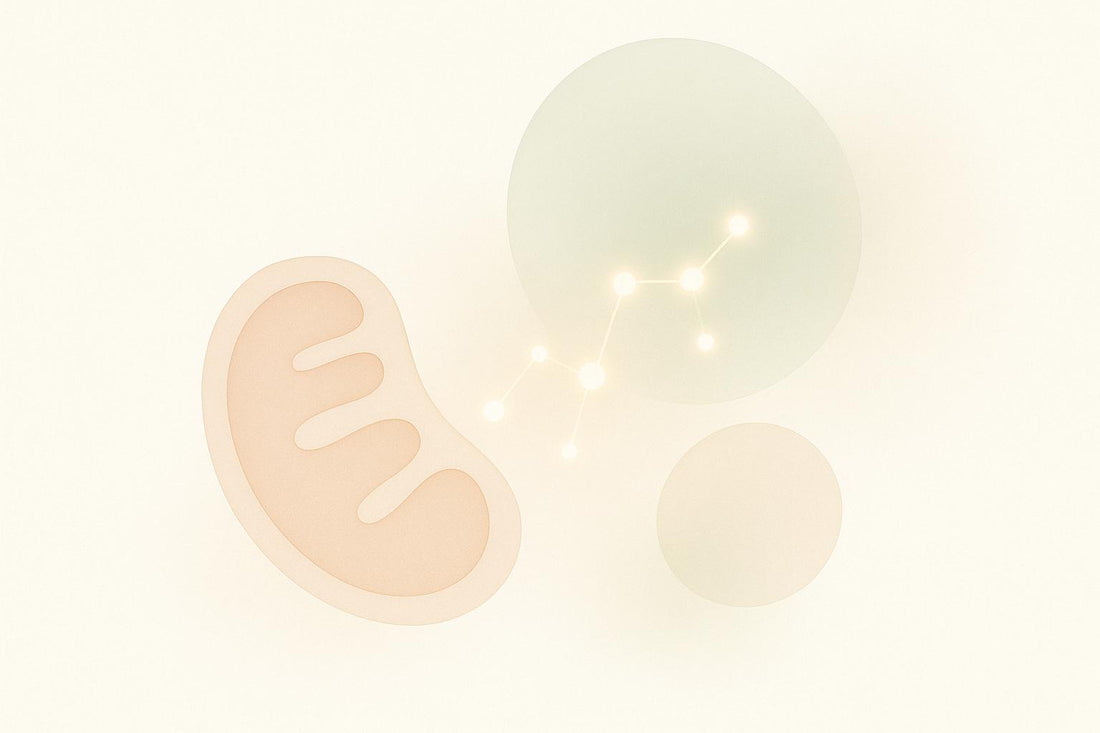Mitochondrial biogenesis is how your cells create new mitochondria, the energy producers essential for healthy, vibrant skin. This process keeps skin cells energized, supports repair, and slows visible aging. However, as you age, mitochondrial efficiency declines, leading to reduced energy, slower healing, and signs like wrinkles.
Here’s what impacts this process and how to support it:
- Energy Needs: Skin cells like keratinocytes and fibroblasts rely on mitochondria for ATP production, crucial for regeneration, repair, and collagen synthesis.
- Aging Effects: Mitochondrial function drops with age, increasing oxidative stress and reducing skin elasticity.
- External Stressors: UV rays, pollution, and chronic stress harm mitochondria, accelerating skin damage.
- Support Strategies: Exercise, nutrient-rich diets, supplements (like NMN, Resveratrol, and Spermidine), and good sleep can improve mitochondrial health.
To maintain youthful skin, focus on lifestyle changes and targeted supplements that promote mitochondrial biogenesis and protect against damage.
Beyond the surface: Skin health a key piece in longevity | Anna Mandinova, MD, PhD | TEDxBoston

How Mitochondrial Biogenesis Works in Different Skin Cells
Mitochondria play a vital role in maintaining the health and functionality of skin cells, and understanding their behavior can shed light on the processes behind skin aging. Different types of skin cells have unique energy demands and rely on mitochondria in distinct ways. Keratinocytes, which dominate the outer layer of the skin, and fibroblasts, found in deeper layers, each adapt their mitochondrial activity to meet their specific roles in energy production and structural maintenance.
Mitochondrial Biogenesis in Keratinocytes
Keratinocytes account for about 90% of the skin's outermost layer and undergo a fascinating transformation as they mature. Basal keratinocytes initially rely on glycolysis for energy. But as they differentiate into cells in the upper layers, particularly in the stratum granulosum, their energy production shifts toward mitochondrial oxidative phosphorylation. This shift supports the increased energy demands required for forming the skin's protective barrier. At this stage, keratinocytes also develop a denser mitochondrial network compared to cells in the stratum spinosum, ensuring sufficient energy supply for their functions[1].
Mitochondria in keratinocytes drive biosynthetic pathways essential for producing keratin and lipids, both of which are critical for the skin's barrier function[1]. Research in mice has shown that disrupting mitochondrial transcription factor A (TFAM) in keratinocytes impairs epidermal differentiation, promotes excessive cell proliferation, and weakens the skin's barrier[1]. Additionally, controlled production of mitochondrial reactive oxygen species (ROS) plays a key role in signaling keratinocyte differentiation[3].
Mitochondrial Biogenesis in Fibroblasts
Fibroblasts, located in the dermis (the skin's deeper layer), are responsible for maintaining the skin's structural integrity. These cells rely heavily on mitochondrial activity to produce the extracellular matrix, growth factors, and collagen - all essential for skin strength and elasticity[1]. Collagen synthesis, in particular, is an energy-intensive process, and when mitochondrial biogenesis slows down, it directly impacts the skin's firmness and resilience[4].
How Aging Changes Skin Cell Mitochondria
As we age, mitochondrial function diminishes in both keratinocytes and fibroblasts, but the changes manifest differently in each cell type. In keratinocytes, aging reduces mitochondrial connectivity, leading to less efficient energy production. Although keratinocytes accumulate fewer functional defects over time compared to fibroblasts, aging still affects them. For example, the process of mitophagy - the removal of damaged mitochondria - becomes less efficient in older keratinocytes, reducing ATP production[1].
Aging also brings an approximate 8% decline in ATP production per decade, further highlighting the gradual loss of mitochondrial efficiency[3]. Environmental factors like UV exposure exacerbate this decline. Studies have shown that photo-aged skin exhibits a 10-fold higher rate of a ~5000 bp deletion in mitochondrial DNA compared to sun-protected skin[3]. Additionally, aging slows mitochondrial turnover due to reduced biogenesis and impaired quality control mechanisms like mitophagy[1]. These changes contribute to thinner skin, slower wound healing, and reduced collagen production, emphasizing the need to support mitochondrial health as we grow older.
What Controls Mitochondrial Biogenesis
Grasping the factors that regulate mitochondrial biogenesis sheds light on why some people seem to maintain youthful, healthy-looking skin longer than others. This intricate process is influenced by both the body's internal molecular systems and external environmental conditions.
External Factors That Affect Mitochondria
Environmental stressors can take a toll on skin mitochondria, with UV radiation being a major culprit. UVA rays (320–400 nm) penetrate deeply into the dermis, while UVB rays (290–320 nm) primarily target the epidermis - both causing damage to mitochondria in skin cells[6]. In fact, UV exposure results in ten times more mutations in mitochondrial DNA compared to nuclear DNA[7], which explains the pronounced damage in photo-aged skin. Additionally, pollutants like particulate matter, nitrogen oxides, and ozone contribute to oxidative stress in skin cells[8].
Chronic stress is another factor, as it activates oxidative pathways that impair mitochondrial function[8]. Addressing these challenges requires a combination of strategies: using sunscreens with DNA photolyase to guard against UV-induced mitochondrial damage[7], applying or consuming antioxidants to combat oxidative stress, and managing stress to support overall cellular health[7][8]. These external stressors highlight the importance of strong internal mechanisms for maintaining mitochondrial function.
Molecular Pathways That Control Biogenesis
While external factors can strain mitochondria, internal molecular pathways work to ensure their upkeep. In skin cells, mitochondrial biogenesis is primarily governed by two key pathways: the PGC-1α signaling cascade and the Nrf2/ARE signaling cascade. PGC-1α acts as a coactivator, collaborating with nuclear respiratory factors NRF1 and NRF2 to regulate mitochondrial DNA transcription[5]. When cells need more energy - such as during tissue repair - PGC-1α drives the production of proteins like TFAM, TFB1M, and TFB2M, which are essential for creating new mitochondria[5].
Regulating PGC-1α involves a balancing act. AMPK activates PGC-1α by phosphorylating it, which in turn stimulates SIRT1 to deacetylate PGC-1α and promote biogenesis[5]. On the flip side, GSK3β can phosphorylate PGC-1α, leading to its degradation and reduced activity[5].
The Nrf2 pathway plays a dual role by protecting cells from oxidative stress and aiding mitochondrial biogenesis. Under normal conditions, Nrf2 remains bound to Keap1 in the cytoplasm, where it is marked for degradation. However, during oxidative stress, Nrf2 moves to the nucleus and binds to antioxidant response elements (AREs) in specific gene promoters[5]. AMPK also influences Nrf2's movement, and PGC-1α further boosts antioxidant gene expression by activating Nrf2[5].
Nutrients That Support Mitochondrial Biogenesis
Certain nutrients can complement these molecular processes by helping sustain and enhance mitochondrial biogenesis. Nicotinamide Mononucleotide (NMN) is one such nutrient, as it raises NAD⁺ levels, which naturally decline with age, supporting energy production and DNA repair[9]. Research suggests that daily doses of 250 to 1,000 mg of NMN can effectively aid energy production[9]. Resveratrol works in tandem with NMN, while pterostilbene offers better absorption and stability[9].
Spermidine, a polyamine found abundantly in human tissues, also diminishes with age. Taking 1–2 mg daily can encourage autophagy, the process of clearing out damaged mitochondria to make room for healthier ones[9].
"I've recently started taking spermidine as well, because we want to induce autophagy. And that would help induce what fasting would already do or it would help accentuate the benefits of fasting."[9]
Fisetin is another helpful nutrient, as it aids in removing aging cells that release inflammatory signals. A daily dose of 500 mg is recommended for this purpose[9]. CoQ10 also supports mitochondrial health by optimizing the electron transport chain, which is essential for energy production[9].
Brands like MASI Longevity Science offer supplements that include NMN, Resveratrol, Fisetin, and Spermidine, all designed to address aging at its core and promote mitochondrial health in the skin.
Additionally, natural compounds like lycopene, curcumin, and EGCG can complement these targeted supplements, contributing to a broader approach for maintaining cellular health and function[7].
sbb-itb-4f17e23
How to Support Mitochondrial Biogenesis for Healthy Skin
Boosting mitochondrial biogenesis is a key step toward achieving healthier, more resilient skin. By focusing on practices that support the mitochondria in your skin cells, you can work toward a glowing, vibrant complexion.
Lifestyle Changes to Improve Mitochondrial Function
Your daily habits play a huge role in how well your skin’s mitochondria function. Studies show that factors like diet, exercise, sleep, and stress management directly impact skin health and mitochondrial activity [10].
Exercise is one of the most effective ways to encourage the production of new mitochondria. Regular physical activity improves blood flow to the skin and promotes mitochondrial biogenesis. For example, research shows that older adults and postmenopausal women who exercise regularly experience a 1.5-fold improvement in skin blood flow [10].
"This review demonstrates that exercise can potentially enhance skin function retention." – Ryosuke Oizumi, Yoshie Sugimoto, Hiromi Aibara [10]
Both aerobic and resistance exercises are beneficial. The key is to stay consistent. Moderate, regular workouts often yield better results for mitochondrial health than sporadic bursts of intense activity.
Nutrition is equally important. A diet loaded with antioxidants, B vitamins, CoQ10, and magnesium provides the raw materials mitochondria need to thrive. Foods like berries, leafy greens, and even dark chocolate can help protect mitochondria from oxidative damage [11].
Intermittent fasting has also been shown to benefit mitochondrial health by improving insulin sensitivity, promoting autophagy (the body’s natural cleanup process), and reducing inflammation [11].
Sleep quality is critical, too, as your mitochondria repair themselves while you rest. Aim for 7–8 hours of sleep per night [11].
Managing stress is another essential piece of the puzzle. Chronic stress can harm mitochondria, but practices like mindfulness and meditation can help mitigate its effects [11].
Lastly, protect your skin from UV radiation, as it can damage mitochondria and accelerate aging [10].
These lifestyle adjustments provide a strong foundation for mitochondrial health, paving the way for additional support through supplementation.
How MASI Longevity Science Supplements Help

While lifestyle changes are essential, supplements can give your skin’s mitochondria an extra boost. MASI Longevity Science offers supplements designed to support mitochondrial function and combat signs of aging. Their formulas feature NMN, Resveratrol, Fisetin, and Spermidine - each chosen for its role in maintaining mitochondrial health [12][13].
- NMN (Nicotinamide Mononucleotide): NMN is a precursor to NAD⁺, a molecule that mitochondria rely on for energy production. Unfortunately, NAD⁺ levels drop by half as we age. NMN supplementation helps restore these levels, improving mitochondrial performance and reducing inflammation [12].
- Resveratrol: Known for its antioxidant and anti-inflammatory properties, Resveratrol protects cells from oxidative stress and UV damage, complementing NMN’s effects [12].
- Fisetin: This compound helps remove aging cells that release inflammatory signals, promoting healthier mitochondrial activity.
- Spermidine: By encouraging autophagy, Spermidine helps clear out damaged mitochondria, making room for newer, healthier ones.
Research suggests that supplements combining these ingredients can mimic some of the benefits of exercise by activating genes involved in mitochondrial and antioxidant pathways [13]. MASI Longevity Science produces its supplements in Germany, using high-quality ingredients that undergo independent testing in Switzerland for purity and safety.
New Therapies for Mitochondrial Health
While lifestyle changes and supplements are accessible and effective, cutting-edge therapies are also showing promise for boosting mitochondrial health.
Emerging treatments include stem cell-based therapies, gene-modified approaches, exosome-based treatments, and even mitochondrial transplantation. For example, mesenchymal stem cells (MSCs) and neural stem cells (NSCs) can enhance mitochondrial function through signaling and direct transfer. Tools like CRISPR-Cas9 allow for precise editing of mitochondrial DNA, while exosomes deliver bioactive molecules directly to target cells. Mitochondrial transplantation, though still in its early stages, has shown impressive results, such as a 20% improvement in heart function in a 2017 study [14].
For now, the most practical methods remain lifestyle adjustments and supplementation. A diet rich in plant polyphenols, ketogenic eating patterns to boost ketone production, and simple practices like alternating hot and cold water exposure can all benefit mitochondrial health [15].
As research continues to evolve, these advanced therapies may one day work alongside current strategies to further enhance skin health and mitochondrial function.
Benefits and Challenges of Improving Mitochondrial Biogenesis
Understanding the upsides and potential downsides of mitochondrial biogenesis is key to optimizing skin health. While the advantages are promising, it's essential to approach this process carefully. Let’s explore how boosting mitochondrial biogenesis impacts skin care, balancing its benefits with possible challenges.
Benefits of Boosting Mitochondrial Biogenesis
Supporting mitochondrial biogenesis can lead to better skin barrier function, enhanced repair processes, and slower signs of aging.
- Stronger skin barrier: Healthy mitochondria provide the energy needed to maintain skin’s protective barrier, improving hydration and reducing irritation. This leads to smoother, more hydrated skin.
- Improved repair mechanisms: When mitochondria function efficiently, skin cells repair damage - caused by UV rays and environmental stress - more effectively.
- Slowing skin aging: Mitochondrial dysfunction is closely tied to aging and related skin conditions. Addressing mitochondrial health targets one of the root causes of aging rather than just masking its effects.
Scientific studies back these benefits. For instance, a 2018 mouse study found that animals with depleted mitochondrial DNA experienced reduced energy production, wrinkling, and hair loss. When mitochondrial function was restored, researchers noted improvements in both skin and hair quality [16]. Additionally, promoting healthy mitochondrial activity has been shown to aid wound healing, with animal studies highlighting enhanced tissue repair and new blood vessel formation [16].
Potential Risks to Consider
While the advantages are clear, there are also risks to be mindful of:
- Oxidative stress imbalance: Overproduction of reactive oxygen species (ROS) can lead to damage, so maintaining a balance is crucial.
- UV vulnerability: UV exposure increases ROS levels, leaving mitochondria more susceptible to harm.
- Overactive pathways: Excessive mitochondrial biogenesis can lead to dysfunctional mitochondria if not regulated.
- Individual differences: Factors like genetics, age, and overall health influence how individuals respond to mitochondrial enhancement strategies.
These risks can often be mitigated with thoughtful approaches. For example, applying antioxidants locally has been shown to reduce oxidative stress and protect against skin aging [2]. Research also suggests that controlled ROS production can deliver positive effects without tipping the balance [16].
Benefits vs. Challenges Comparison
| Aspect | Benefits | Challenges |
|---|---|---|
| Skin Barrier Function | Better hydration and protection | Requires consistent and careful maintenance |
| Repair Mechanisms | Faster, more efficient repair | Results may vary based on individual factors |
| Aging Prevention | Tackles root causes of skin aging | May take time to see visible improvements |
| Oxidative Stress | Balanced ROS levels aid healthy signaling | Risk of imbalance if not properly managed |
| UV Protection | Greater resilience to environmental damage | Sun-exposed areas remain vulnerable |
| Implementation | Various effective strategies available | Needs a holistic, personalized approach |
Practical Applications
Despite the challenges, a balanced and well-thought-out approach to mitochondrial biogenesis can significantly benefit skin health. Therapeutic strategies aimed at mitochondrial dynamics, biogenesis, and autophagy are being explored for their role in healthy aging and preventing age-related conditions [17].
For those looking to incorporate these insights into their routine, MASI Longevity Science offers supplements like NMN, Resveratrol, Fisetin, and Spermidine. These products are designed to support mitochondrial health while minimizing risks. Developed with input from experts at Harvard Medical School and Mayo Clinic, these supplements use carefully measured doses of high-quality ingredients to maximize benefits safely.
Key Takeaways
Mitochondrial biogenesis plays a crucial role in skin renewal and maintaining a strong barrier. Understanding this process can help refine your anti-aging approach.
Main Points About Mitochondrial Biogenesis
Skin renewal relies heavily on mitochondrial energy to sustain its protective barrier and maintain a youthful appearance. Studies show that mitochondrial dysfunction is a key marker of aging [2].
Epidermal progenitor cells, which are highly active metabolically, require significant amounts of ATP to meet their energy needs [2]. Proper mitochondrial biogenesis supports the skin’s ability to repair damage caused by UV exposure and other environmental stressors.
However, NAD+ levels - a critical factor for mitochondrial function - decline sharply with age, negatively impacting skin health [18]. Factors like UV exposure, oxidative stress, nutrient intake, and cellular signaling pathways all influence mitochondrial biogenesis. By managing these elements through lifestyle changes and targeted supplements, you can significantly boost skin health and resilience.
How MASI Longevity Science Supports Skin Health
MASI Longevity Science focuses on improving mitochondrial health through scientifically developed supplements aimed at enhancing cellular energy production. One standout product is their Premium NMN supplement, which is designed to restore NAD+ levels to 100% of the body’s optimal capacity [18], directly supporting mitochondrial biogenesis in skin cells.
MASI’s NMN is verified at a 99.1% purity level [18], providing the essential building blocks needed for optimal mitochondrial function. With an average rating of 4.82/5 from 110 reviews [18], users frequently report increased energy and improved overall well-being.
Dr. Wolfgang Bucke, Ph.D., shares his perspective:
"I'm convinced that MASI supplements enhance cellular health and address several aging-related issues. It's a key component of my overall longevity strategy. This strategy includes MASI, regular exercise and a balanced diet, all working together to support a vibrant and healthy life in the years to come." [18]
MASI’s supplements are manufactured in Germany using pharmaceutical-grade raw materials and undergo independent testing in Switzerland to ensure purity and safety [18]. This rigorous quality control guarantees that users receive effective mitochondrial support without unnecessary additives.
For optimal results, MASI recommends 1 capsule daily for individuals aged 40–50, and 2 capsules for those over 50 [18]. To enhance absorption, NMN should be taken on an empty stomach in the morning, ideally an hour before breakfast [18].
In addition to NMN, MASI offers complementary supplements like Resveratrol, Fisetin, and Spermidine. These products work together to address multiple aspects of cellular aging, promoting mitochondrial health and encouraging cellular renewal for healthier, more resilient skin.
FAQs
What lifestyle changes can help boost mitochondrial biogenesis in skin cells?
Lifestyle adjustments can greatly influence mitochondrial biogenesis - the process of generating new mitochondria in skin cells. This, in turn, contributes to healthier and more youthful-looking skin.
Engaging in regular physical activities, especially aerobic exercises like jogging or cycling, is known to encourage the production of new mitochondria. Similarly, making dietary changes, such as practicing calorie restriction or cutting back on sugar, has been linked to better mitochondrial performance, boosting energy production at the cellular level.
Together, these habits can enhance skin vitality, support cellular renewal, and may even help slow down visible signs of aging. Incorporating these practices into your routine can strengthen your skin’s natural ability to remain vibrant and resilient.
How do NMN, Resveratrol, and Spermidine support mitochondrial health and improve skin vitality?
NMN works to enhance mitochondrial health by raising NAD+ levels, a critical component for generating cellular energy and repairing DNA. This boost helps skin cells stay vibrant and robust.
Resveratrol triggers sirtuins, proteins vital for creating new mitochondria and offering antioxidant defense. By reducing oxidative stress and supporting cellular activity, it plays a role in improving skin health.
Spermidine encourages autophagy, the body's natural process for removing damaged mitochondria and refreshing cells. This leads to better cellular renewal, promoting healthier and more youthful-looking skin.
How does aging affect mitochondrial function in keratinocytes and fibroblasts differently?
Aging affects the mitochondria in keratinocytes and fibroblasts differently, playing a key role in the visible signs of skin aging.
In keratinocytes, the aging process reduces mitochondrial respiration and increases oxidative stress. This combination disrupts the health of the epidermis, speeding up the overall aging of the skin. Meanwhile, fibroblasts face mitochondrial DNA damage and a drop in complex II activity. These changes lead to structural issues, weakening the extracellular matrix (ECM) and reducing skin firmness.
Although mitochondrial decline occurs in both cell types, the effects differ: keratinocytes primarily experience functional problems in the epidermis, while fibroblasts endure structural damage that impacts the dermis.




